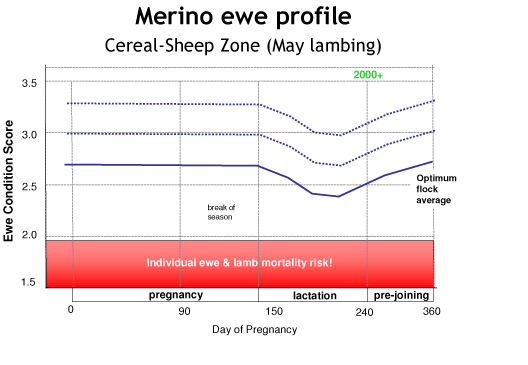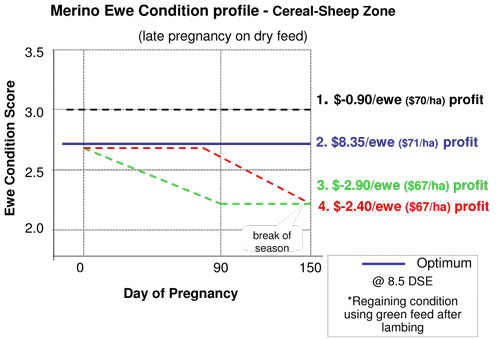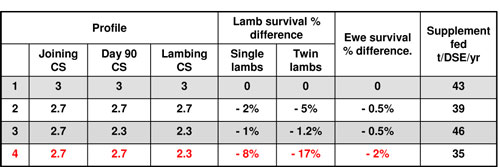|
| This zone is
characterised by
winter rainfall
and hot summers
with no
effective
rainfall.
Crops form a
substantial part
of enterprises
and most
properties have
stubbles
available for
grazing.
Pastures are
predominantly a
mix of annual
grasses, sub
clover and
medics.Due to a
shorter growing
season than
the medium
rainfall zone
the constraints
of lower feed on
offer and total
pasture
production
(2-5t/ha/yr)
affect the
recommendations
for optimum ewe
management.
These
all affect
the potential
stocking rate
and pasture
utilisation and
therefore
affects some of
the
recommendations
for ewe
management.
|

|
Optimum Ewe Condition
Score Profile
Production from ewes and
their progeny can be
predicted with confidence if
the condition of the
ewe throughout the
season is known. Using these
known production levels and
matching them with the
pasture available for
the time of lambing and
expected supplementary
feeding costs allows an
optimum ewe Condition Score
(CS) profile to be
developed. The profile
sets the CS targets for key
times during the
reproductive cycle. Ewe CS
at joining and at lambing
are the key points on the
profile with condition at
lambing being the most
important.

Key
Points about the May
Lambing Profile:
-
Maintaining
condition from
joining through
to lambing is
the most
profitable
approach to
managing ewes
for a may
lambing in the
300-420mm zone.
-
The shape of the
profile is as
important as the
actual starting
condition score
of the ewes, so
if ewes are in
CS 3.5
pre-joining the
most profitable
approach is to
maintain their
condition
through to
lambing.
Similarly if the
ewes CS is 2.5
at joining the
most profitable
approach is to
maintain their
condition.
-
Ewe CS for
joining is
influenced by
the
condition post-weaning
and therefore it
is important to
monitor changes
in ewe condition
between weaning
and joining.
-
The break of
season is
usually close to
lambing and
paddocks should
be deferred
until a feed
wedge is grown
(at least 700
FOO with the
optimum 1500 FOO
in lactation).
-
The higher the
lambing CS of
the ewes, the
lower ewe and
lamb mortality
will be,
especially in
twinning ewes.
-
Losing condition
(or not
regaining
condition)
in the
period before
lambing has the
biggest impact
on lamb survival
and progreny
production.
- Condition at
lambing is a key
target as this
affects lamb and ewe
survival. It
is not recommended
any breeding ewe is
in CS 2 or lower as
there are
significant
mortalities of ewes
and lambs
particularly
twins.
- Ewes in
early
lactation will tend
to lose condition as
any available energy
is channelled into
milk
production.
Higher pasture FOO
gives high lamb
growth rates.
- Ewes will regain
condition on green
feed post peak
lactation (~30
days).
Supplementary feeding through
Autumn to maintain condition
is the most profitable
management option.
Maintaining condition,
compared to gaining
condition, gives the most
efficient conversion of
feed. It is important then
to not allow any loss of
condition if it needs to be
re-gained prior to lambing
using grain. Although feed
costs are high, losing
condition or having too low
a condition by lambing will
also decrease the survival
of lambs and increase the
mortality of ewes during
lambing, thereby affecting
profit and production.
Cost of missing targets at
lambing

Figure
2.
Profile
1. Profit is
similar to the
optimum but requires
a lower stocking
rate (0.5 DSE).
Profile 2.
Optimum due to
maintenance
feeding in
pregnancy and
regaining
condition on
green feed in
lactation.
Profile 3.
Profit is lower
due to the loss
of production
and lower
survival caused
by low condition
prior to lambing
and the cost of
grain feeding in
early pregnancy
.
Profile 4. Ewe
and lamb
mortality limits
profitability
through lamb and
ewe survival as
well as
lifetime wool
production of
the progeny.
Trade-offs of risk for
profit
The optimum profile
shown in Figure 1.
takes into account
both profitability
and the health of
the ewe flock. The
other profiles,
shown in Figure 2,
offer only small
differences in
profitability but
there are some
important trade-offs
in production to
consider if
following these
profiles.
Ewe mortality
generally increases
with lower ewe
condition by lambing
(although there are
other factors that
influence this, such
as weather, age and
available feed). Ewe
condition in late
pregnancy has a
large impact on lamb
birth weight and
therefore lamb
survival. Twin
lambs are more
sensitive to this
change in birth
weight (&
survival) as their
birthweight is
usually lower than
the optimum. Table 1
shows the effect of
several profiles on
both lamb and ewe
survival.

Table 1. Difference
in survival of ewes
and lambs for late
lambing flocks
compared to
maintaining
condition score 3
throughout pregnancy
in the Cereal-Sheep
Zone.
Following a
lower profile
(profile 4) to the
optimum (profile 2)
at lambing means
that by
lambing the
flock average will
be CS 2.2 with a
significant
proportion of the
mob below the
recommended CS 2
minimum. This
leads to severe
penalties in ewe and
lamb mortality.
Profile 4 in Table 1
shows that twin
lambs have a
predicted decrease
in survival of 17%
compared to
maintaining in CS 3
throughout. This can
be compared to the
optimum profile
which has a decrease
in twin lamb
survival of 5%.
Following the
lower profile has no
room for getting it
wrong or provides no
buffer in poor
lambing conditions.
Running Lower Stocking Rates
Producers may choose
to run flocks at
stocking rates lower
than are recommended
for maximum
profitability. There
are many legitimate
reasons for doing
this, including
fitting around
changing crop
rotations, however,
for producers who
wish to improve
profitability, ewes
per hectare are the
biggest driver of
profitability.
By following the
lifetimewool ewe
profile, you can
identify
opportunities to
lift stocking rate
safely during
periods where CS
targets are being
met easily.
In years that ewes'
peak condition prior
to joining is above
the recommended
target due to a
great season or
flock restructuring,
it is worthwhile
following the same
trend of maintaining
condition score from
joining to lambing
for that season
rather than trying
to drop condition to
a lower profile.
Continuing to run
ewes at this higher
flock condition
score year in year
out will give a
slightly lower
profitability to
running ewes at the
optimum profile, as
the higher
production gains are
offset by the higher
cost of
supplementation.
More details on the
economic impacts of managing
ewes and the cost of missing
targets can be found in the
Economics
section.
Detailed production
impacts can be
found in the Ewe
Management section
or click on the topic below;
Pasture photos, condition
scoring and feed budgeting
guides for managing ewes to
CS profiles can be
found in the Tools section
For more information on
lifetimewool in Victoria
please contact:
Ralph Behrendt
,
DPI Hamilton, ph:
03
55730979
Back to
Top
|